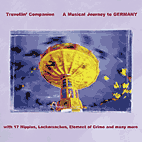|
1. Folkabbestia: Azzurro 2:54
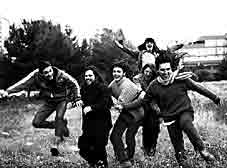 |
Folkabbestia already have an established name
in the Italian peninsula. The mixture of rock, tarantelle, canzone
Italiana, Irish folk and ska rhythms, with the energy of a rock
band, often opens some interesting musical perspective: the south
of Italy is always present, with its warm and beautiful melodies,
and the passion for immortal, evergreen songs, in this case the
Balcan flavoured cover of "Azzurro". |
2. Mau Mau: Makè Manà
5:20
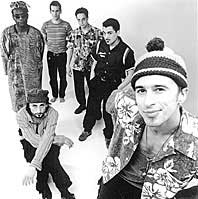 |
Mau Mau is a Piedmontese
word used to define tramps, immigrants, people who come from
the south of Italy or rather from the rest of the world. With
a raw acoustic sound they create musical landscapes that link
the mountains to the sea, and the sea to the opposite Mediterranean
coastline. Their songs tell stories of the poor, the transmigrates,
of suburbs and the lost "American Dream". Not only
do they use the Italian and the Piedmontese language to create
a new dialect, they also build a bridge between the regional
culture and the beats that shake the rest of the world. |
3. Novalia: Perzu Pe 'Na Creuza
De Ma 4:46
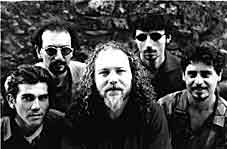 |
Novalia from the central-Italian region of Lazio
blend the traditional music and instruments from this area with
electric guitars and sampling machines. Singing in the local
dialect "represents our roots, the instinctive expression
of our musical sensitivity. The voices of many 'Italies' all
have fascinating stories to tell", the band explains. |
4. Agricantus: Carizzi R'Amuri
4:44
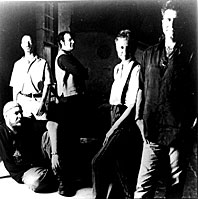 |
Agricantus, from Sicily, mix the music of the
Mediterranean with ambient and trance rhythms. In 1996 they went
to the desert of Mali to record with nomad musicians. The result
was the internationally acclaimed 'Tuareg' album from which 'Carizzi
R'Amuri' is taken. It's an amazing blend of Berber percussion,
ancient instruments, voices and sounds of the desert, plus sequencers. |
5.Mazapegul: Bandido 5:13
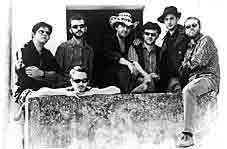 |
Mazapegul derives from 'Mazapegolo', an elfin
spirit which is featured in legends of the central Italian region
of Romagna. Formed in 1994, they use folk traditions from Italy,
the Middle East and Africa and assimilate them in their own non-traditional
arrangements - a mainly acoustic 'crossover' music with an original
and highly energetic slant. |
6. Càlic: Cap-Caldaru
3:39
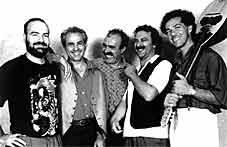 |
Càlic started studying the traditional
music of Sardinia in 1981. The members recovered and reconstructed
typical instruments like the mandola, ximbomba, serraggia and
zucchitta for a reworking of traditional songs, and for new compositions
in both Sardinian and Catalan dialects. They feel a strong desire
to save a musical patrimony, even in modern compositions like
'Cap-Caldaru'. |
7. Mario Salva: Non C'e Rosa
Senza Spina 3:40
 |
Mario Salva is an organetto (accordion) virtuoso
and a polychrome composer inspired by the tarantellas, oriental
rhythms and fanfara dances of the traditional south Italian repertoire
- a true master of the Neapolitan and Apulian tarantella dance
music. |
8. Tammurriata Di Scafati:
E Scappato 'O Lione 3:27
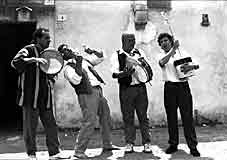 |
As the rhythm masters of the Vesuvio, the Tammurriata
di Scafati represent the most characteristic expression of Neapolitan
dance and music. The voice of two singers rise on the beat of
their principal instrument: the tammorra, a frame drum with tin
cymbals. Traditionally the dance which goes with the tammorra
tells about the labour of love and painful work, in gestures
typical of common people's life. The Tammurriata di Scafati are
active during the traditional ceremonies around the volcano and
in concerts all across Europe. |
9. Acquaragia Drom: Tromba
De Zingari 5:19
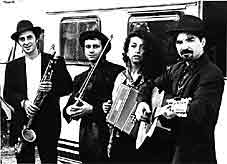 |
Acquaragia Drom reconstruct a musical journey
of gypsy caravans - a gypsy road from the sinti and manouche
swing of the Alps, the saltarello in Abruzzo and Molise, the
frenetic tarantella from Sicily, Puglia and Calabria to the Neapolitan
and Roman gypsy serenata. This is sacred and profane music played
at weddings and traditional feasts. The band uses an ironic and
corrosive way to present this repertoire that helps the audience
to laugh and dance. |
10. Ziganamama: Sirba de la
Transylvania 4:03
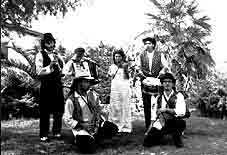 |
Ziganamama is a project born out of the intention
to show the musical crossroads of gypsies and jews. Both ethnic
groups, though with a different backgound, are united by the
same worship for freedom. The band is characterized by matching
up traditional instruments like clarinet, violin, accordion and
percussion with more contemporary ones like guitar, bass and
drums. 'Sirba De La Transylvania' is a Romanian dance mixed with
two tarantelle from Puglia, the region where Ziganamama comes
from. |
11. Daniel Sepe: Raggatruffen
5:01
 |
Multi-instrumentalist Daniel Sepe from Naples
started his diverse musical career in 1976. In numerous bands
and projects he has played all sorts of music from folk to rock
to rap to jazz to film and theatre music. This rich musical menu
sometimes overloads his records with ideas and details, but in
songs like 'Raggatruffen' his musical wizardy shines through
when he combines Italian folk tradition with rap and ragga. His
3rd CD "Vite perdite" was internationally released
through Piranha and gave him a remarkable success followed by
invitations to important jazz and world music festivals. |
12. Nidi D'Arac: Pipe, Canella
E Mmacarie 3:40
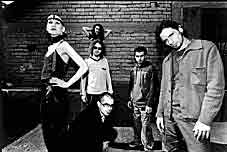 |
Nidi D'Arac successfully mixes traditional folk
music with trance rhythms, jungle beats and digital sounds. Coming
from the Salento area and living in Rome now, bandleader Alessandro
Coppola fuses the 'pizzica taranta' with new technology. Nidi
D'Arac reach audiences ranging from folk festivals to techno
raves. Since 1998 they have played an important role in a new
Italian popular music scene. |
13. Bonifica Emiliana Veneta:
Manfrine Nove 4:12
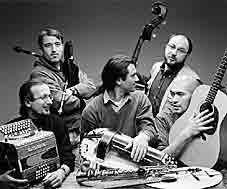 |
B.E.V. means Bonifica Emiliana Veneta. As the
band explains, Bonifica is the action to drain marsh soil and
to transform it into cultivatible land. Emiliana and Veneta are
regions in the Northern Appennini mountains. "We chose that
name to describe a personal desire to live our traditions freely
- at the same time to stick to the roots of our music, but also
to get away from inflexible traditions."B.E.V., who descend
from the popular band 'La Piva dal Carner', mix traditional instruments
like the piva (Italian bagpipe) and hurdy gurdy with sax, accordion
and guitar. |
14. Barabàn: La Brunetta
2:54
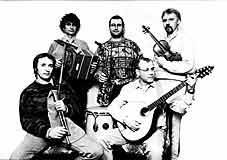 |
Founded in 1986 in Milan, Barabàn is both
a small orchestra and a vocal quartet that interprets and revives
the music of the Po river plain. Having played more than one
thousand concerts and re-corded 5 CD's, Barabàn developed
a unique musical synthesis that joins tradition with future,
the sound of northern Italy with music from other countries.
'La Brunetta' is an example of the acappella side of one of the
most diverse bands in the Italian roots revival. |
15. Marino De Rosas: Mediterraneo
3:13
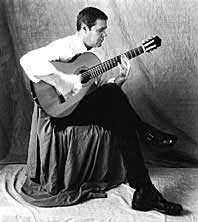 |
Marino De Rosas is a Sardinian guitarist who,
over many years of studying the instrument, developed an entirely
unique technique for performing and composing original scores.
On 'Mediterraneo' the guitar was recorded without the use of
overlaying sounds, but with traditional Sardinian instruments
which today are seen more often on display in museums than on
stage. The result is a unique blend of styles, brought forth
also through the use of reed instruments, reminiscent of the
artisan's country workshop, and the sounds and flavors of an
ancient Sardinia. |
16. Riccardo Tesi + Banditaliana:
Tevakh 5:15
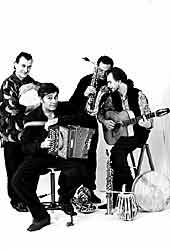 |
After a 20 year artistic career, organetto and
melodeon player Ricardo Tesi followed a call from his 'homeland'
Tuscany, to form the quartet Banditaliana and to play a kaleidoscope
of musical styles ranging from Tuscany folk music to jazz to
the music of the Mediterranean to African rhythms. 'Tevakh',
the song selected for this compilation, is the fruit of Tesi's
collaboration with Madagascan valiha virtuoso, Justin Vali. |
17. Calicanto: Venessia Dai
4:34
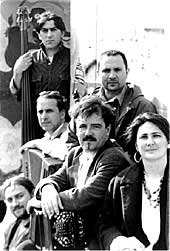 |
Calicanto from the northern Italian region of
Veneto has been delving into the area's musical history for some
fifteen years, re-evoking the sounds of the past and reconstructing
traditional folk instruments. In their music, Calicanto use the
tales of the past to speak about the present. The city of Venice,
its taste, curiosity and tolerance was the main source of inspiration
for their second album 'Venexia' , from which the closing track
'Venessia Dai' was taken. |
A PATH ALONG THE SEA
"Riccu rima a delittu"
sings Raffaello Simeoni (Novalia) in his homage to Fabrizio De
Andrè. "Rich rhymes with crime": today the twenty
Italian regions share once again the richness of a common Italian
language but only a few seem to be concerned by the crime of
allowing regional languages and local dialects to die out.
A unified country only since
1860, it took Italy some five generations, compulsory military
service, two world wars, a Marshall Plan, and national radio
and television to forget regional and local traditions, often
to opt for a parody of (supposedly) Northern American cultural
pattern. This is why "Creuza de ma", recorded by Fabrizio
De Andrè and Mauro Pagani in the mid-Eighties stands as
a turning point for the Italian roots scene, showing an extraordinary
ability to combine old and new sounds from Italy and its neighbouring
nations. They produced a unique clothing of sounds for the old/new
Genoese language finally on record after decades of nurturing
the Italian lyrics of one of the most beloved Italian singers.
As Novalia skilfully acknowledge,
most of the labels and artists featured in this compilation are
spiritual daughters and sons of "Creuza de ma", a "path
along the sea". They rarely make use of the Italian language
and they rarely confine themselves within a single local tradition.
They bear witness to a wide geographical and cultural spread.
The traditional material is usually the first musical source
though the main focus is modern song formats. Wind-hunters on
a boat in the middle of crossroads between East and West, Italian
roots music groups have their Northern dock in continental Europe
and their Southern anchor in the Mediterranean waters.
Of course, there's no need
to find an equilibrium as there is not "one" Italian
musical tradition. Nevertheless, for those who are seeking some
signs on the Italian map, the country can be roughly divided
into four broad musical regions.
The combination of the Alpine
and of the Po Valley regions provides a distinct character to
the music of the North, well represented here by groups from
Emilia Romagna (Bonifica Emiliano Veneta, Mazapegul), Lombardia
(Barabàn) and Piedmont (Mau Mau).
The Apennine mountains cut
across Central Italy, hosting open minded and well travelled
musicians from Tuscany (Riccardo Tesi + Banditaliana), Lazio
(Novalia), Umbria, Marche, Abruzzo and Molise.
The remaining four regions,
Campania (Daniele Sepe), Puglia (Mario Salvi, Folkabbestia),
Calabria, Sicily (Agricantus) are traditionally known as Meridione
(the South). Here the rhythms of the frame drums are still alive
and well, as witnessed by the traditional tammurriata of the
old and new generations from Scafati or by the progressive rendition
by Nidi d'Arac.
Sardinia is a world of music
in itself. The island is a source of inspiration not only for
Sardinian artists (Càlic, Marino De Rosas), but also for
outstanding instrumentalists from other regions such as organetto
(diatonic accordion) player Riccardo Tesi who in "Tevakh"
builds a fascinating bridge between Sardinian and Malagasy rhythms.
Beyond simplistic categorisations, Italian roots music remains
nomadic by nature and quite at ease with recent and ancient influences
from gypsy and klezmer music such as those heard in the tunes
by Acquaragia Drom (Rome) and Ziganamama (Bari, Puglia).
Enjoy!
Alessio Surian
Contributor to the Rough Guide
to World Music
|


